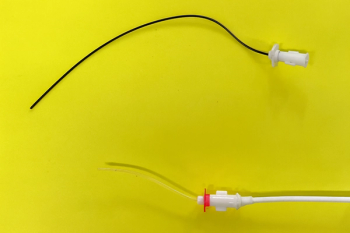
Journal Scan: Is there an optimal food type for cats with idiopathic cystitis?
Feeding a cystitis-prevention diet may be of benefit, but the exact food components responsible for the beneficial effect is unclear.
Why they did it
Feline idiopathic cystitis (FIC) is a common cause of hematuria, dysuria, pollakiuria and periuria in both male and female cats. Few agents and procedures proposed to manage cats with FIC have been evaluated in clinical trials. Dietary management specifically has only been evaluated in two clinical studies. The authors of this randomized, controlled clinical trial evaluated the efficacy of a commercially available multipurpose, cystitis-prevention food compared with a control diet for the management of cats with FIC.
What they did
The authors enrolled 31 client-owned cats in which FIC was diagnosed between June 2009 and October 2010. FIC was diagnosed based on two or more compatible clinical signs within the preceding seven days (e.g. dysuria, hematuria, pollakiuria, stranguria) as well as evaluation of a complete blood count (CBC), serum chemistry profile, FeLV and FIV testing, urinalysis including a pH determination by meter, quantitative aerobic bacterial urine culture, survey abdominal radiography and abdominal ultrasonography. All cats were between 1 and 8 years of age, housed indoors, neutered, and current on routine vaccinations. Excluded from the study were cats with certain medical and nutritional interventions within the previous seven to 30 days; evidence of major organ disease, urethral obstruction or vertebral disease; another identifiable cause of lower urinary tract (LUT) signs; persistent LUT signs of 14 days' duration; or a pattern of voiding on vertical surfaces, as were cats that resided in a home with more that one additional cat.
The researchers randomized the cats to receive either a cystitis-prevention diet (Prescription Diet c/d Multicare Feline Dry) or a control diet custom manufactured to mimic commonly available commercial adult feline maintenance foods. The owners could choose to feed either dry or wet formulations of the foods, and the diets differed only in antioxidant, fatty acid and mineral profiles. The clients and clinical care team were masked as to which cats were fed which food.
In addition to providing ample amounts of fresh water, the owners were instructed to feed solely the study diet (following a seven-day transition period) for 12 months. The owners were also instructed to record their daily observations of five clinical signs-dysuria, hematuria, periuria, pollakiuria and stranguria. If two or more LUT signs were noted within 24 hours, immediate reevaluation was recommended. A physical examination, urinalysis (including pH) and urine bacterial culture were performed at one, three, six, nine and 12 months. Abdominal radiographs were repeated at six and 12 months, and a CBC and serum chemistry profile were repeated at 12 months.
After improvement in clinical signs, the presence of two or more LUT signs on any given day during the study period was considered evidence of recurrence. The researchers note that this approach was taken in part to mitigate the effects of behavioral disorders (periuria) that may persist even in light of resolution of underlying cystitis.
What they found
The most common clinical sign noted in all cats was periuria, while hematuria in the absence of pyuria was the most common urinalysis abnormality found on urinalysis. The researchers noted no significant differences between the two groups in terms of diet formulation (wet or dry), age, sex, number of cats in the household, body weight, body condition score, history of previous episodes of LUT signs, history of previous consumption of prevention diets, clinical signs or duration of clinical signs before enrollment. There was also no significant difference between the groups with respect to the presence of environmental stressors or environmental enrichment strategies (e.g. scratching posts, window perches) over the course of the study.
The researchers found that the incidence rate of recurrent episodes was almost eight times lower among cats fed the prevention diet compared with those in the control diet group (relative risk, 7.89; 95% con?dence interval, 3.58 to 17.36; P = 0.013). The researchers note, however, that not all cats with recurrent clinical signs returned for reevaluation, so whether another cause for the LUT signs was present could not be determined in many instances. The authors found that cats in the control food group were also more likely to require opioid analgesics at some point during the study (P = 0.02).
In addition, the researchers found that “[t]he mean incidence rate of episodes of individual signs for hematuria, dysuria and stranguria was signi?cantly lower in cats fed prevention food, compared with cats fed control food.”
Take-home message
Feeding a cystitis-prevention diet may be of benefit in reducing the rate of recurrent episodes of FIC as well as diminishing the occurrence of individual LUT signs such as hematuria, dysuria and stranguria. But the exact food components responsible for the beneficial effects remain unclear.
Kruger JM, Lulich JP, MacLeay J, et al. Comparison of foods with differing nutritional pro?les for long-term management of acute nonobstructive idiopathic cystitis in cats. J Am Vet Med Assoc 2015;247(5):508-517.
Link to abstract:
Newsletter
From exam room tips to practice management insights, get trusted veterinary news delivered straight to your inbox—subscribe to dvm360.



